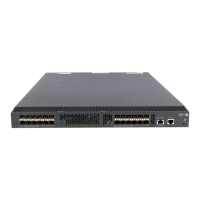172
Configuring port mirroring
The port mirroring feature is available on Layer 2 Ethernet interfaces, Layer 3 Ethernet interfaces, and FC
interfaces. The term "interface" in this chapter collectively refers to these types of interfaces. You can use
the port link-mode command to configure an Ethernet port as a Layer 2 or Layer 3 interface (see Layer
2—LAN Switching Configuration Guide). FC interfaces are available in Release 2311P04 and later
versions.
Overview
Port mirroring refers to the process of copying the packets passing through a port to the monitor port
connecting to a monitoring device for packet analysis.
Terminology
The following terms are used in port mirroring configuration.
Mirroring source
The mirroring source can be one or more monitored ports, which are called source ports. Packets passing
through them are copied to a port connecting to a monitoring device for packet analysis. (The copies are
called mirrored packets.) The device where the mirroring source resides is called a source device.
Mirroring destination
The mirroring destination is the destination port, also known as the monitor port, of mirrored packets and
connects to the monitoring device. The device where the monitor port resides is called the destination
device. Mirrored packets are sent out of the monitor port to the monitoring device.
A monitor port might receive multiple duplicates of a packet in some networks because it can monitor
multiple mirroring sources. For example, assume that Port 1 is monitoring bidirectional traffic on Port 2
and Port 3 on the same device. If a packet travels from Port 2 to Port 3, two duplicates of the packet are
received on Port 1.
Mirroring direction
The mirroring direction specifies that the inbound, outbound, or bidirectional traffic can be copied on a
mirroring source.
• Inbound—Copies packets received on a mirroring source.
• Outbound—Copies packets sent out of a mirroring source.
• Bidirectional—Copies packets received and sent on a mirroring source.
Mirroring group
Port mirroring is implemented through mirroring groups, which include local, remote source, and remote
destination mirroring groups. For more information about the mirroring groups, see "Port mirroring
cl
assification and implementation."

